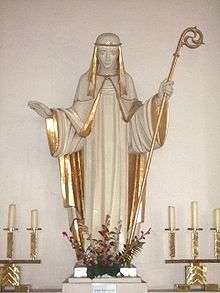Irmgard of Chiemsee
| Blessed Irmgard of Chiemsee | |
|---|---|
 Statue of Irmgard in the Collegiate Church of Buchau | |
| Born |
c. 830/833 Regensburg, Bavaria |
| Died |
16 July 866 Frauenchiemsee |
| Venerated in | Roman Catholic Church |
| Beatified | 17 July 1929 by Pope Pius XI |
| Feast | 16 July |
| Attributes | crowned, in Benedictine abbess's habit, holding abbot's staff |
Blessed Irmgard of Chiemsee (German: Selige Irmgard, also Irmengard; c. 831/833 – 16 July 866), a member of the Carolingian dynasty, was the second daughter of King Louis the German and his wife Hemma. She was the first Abbess of Frauenchiemsee from 857 until her death.[1]
Life
Born at King Louis' court in Regensburg, Bavaria, young Irmgard, like her sisters, was destined for a monastic life. She was raised at the Benedictine abbey of Buchau in Swabia, whose estates she later received from the hands of her father. She was known for her comprehensive education
About 850 Louis appointed Irmgard abbess of the Frauenchiemsee monastery, which had been founded by the last Agilolfing duke Tassilo III of Bavaria in 782 and since 788 held the status of an Imperial abbey. During her leadership the decayed premises were restored and the former chapter for noble ladies developed into a Benedictine convent of nuns.
Since she was of Imperial descent, the incumbent Abbess of Chiemssee had the right to wear a thin golden hoop, resembling a little crown. Modern-era Abbesses, however, refrain from doing so.
Veneration
Irmard was already venerated in the early 11th century, when Abbot Gerhard had her headreliquary translated to Seeon Abbey in 1004. However, her cult was officially recognised only in 1928 by Pope Pius XI, on initiative of Cardinal Michael von Faulhaber. Irmgard was beatified on 17 July 1929. Her mortal remains and her skull were re-unified during a festive ceremony in 2003.
Her feast day is 16 July.[2] In Frauenchiemsee, Irmengardstag is celebrated the Sunday nearest to 16 July. In paintings Irmgard is portrayed in a Benedictine habit either crowned with Bible and abbot's staff or with heart in her hand.
Ancestry
| Ancestors of Irmgard of Chiemsee | |||||||||||||||||||||||||||||||||||||||||||||||||||||||||||||||||||||||||||||||||||||||||||||||||||||||||||||||||||||||||||||||||||||||||||||||||||||||||||||||||||||||||||||||||||||||||||||||||||||||||||||||||||||||||||||||||||||||||||||||||||||||||||||||||||||||||||||||||||||||||||||||||||||||||||||||||||||||||||||||||||||||||||||||||||||||||||||||||||||||||||||||||||||||||||||||||||||||||||||||||||||||||||||||||||||||||||||||||||||||||||||||||||||||||||||||||||||||||||||||||||||||||||||||||||||||||||||||||||||||||||||||||||||||||||||
|---|---|---|---|---|---|---|---|---|---|---|---|---|---|---|---|---|---|---|---|---|---|---|---|---|---|---|---|---|---|---|---|---|---|---|---|---|---|---|---|---|---|---|---|---|---|---|---|---|---|---|---|---|---|---|---|---|---|---|---|---|---|---|---|---|---|---|---|---|---|---|---|---|---|---|---|---|---|---|---|---|---|---|---|---|---|---|---|---|---|---|---|---|---|---|---|---|---|---|---|---|---|---|---|---|---|---|---|---|---|---|---|---|---|---|---|---|---|---|---|---|---|---|---|---|---|---|---|---|---|---|---|---|---|---|---|---|---|---|---|---|---|---|---|---|---|---|---|---|---|---|---|---|---|---|---|---|---|---|---|---|---|---|---|---|---|---|---|---|---|---|---|---|---|---|---|---|---|---|---|---|---|---|---|---|---|---|---|---|---|---|---|---|---|---|---|---|---|---|---|---|---|---|---|---|---|---|---|---|---|---|---|---|---|---|---|---|---|---|---|---|---|---|---|---|---|---|---|---|---|---|---|---|---|---|---|---|---|---|---|---|---|---|---|---|---|---|---|---|---|---|---|---|---|---|---|---|---|---|---|---|---|---|---|---|---|---|---|---|---|---|---|---|---|---|---|---|---|---|---|---|---|---|---|---|---|---|---|---|---|---|---|---|---|---|---|---|---|---|---|---|---|---|---|---|---|---|---|---|---|---|---|---|---|---|---|---|---|---|---|---|---|---|---|---|---|---|---|---|---|---|---|---|---|---|---|---|---|---|---|---|---|---|---|---|---|---|---|---|---|---|---|---|---|---|---|---|---|---|---|---|---|---|---|---|---|---|---|---|---|---|---|---|---|---|---|---|---|---|---|---|---|---|---|---|---|---|---|---|---|---|---|---|---|---|---|---|---|---|---|---|---|---|---|---|---|---|---|---|---|---|---|---|---|---|---|---|---|---|---|---|---|---|---|---|---|---|---|---|---|---|---|---|---|---|---|---|---|---|---|---|---|---|---|---|---|---|---|---|---|---|---|---|---|---|---|---|---|---|---|---|---|---|---|---|---|---|---|---|---|---|---|---|---|---|---|---|---|---|---|---|---|---|---|---|---|---|---|---|---|---|---|---|---|---|---|---|---|---|---|---|---|---|---|---|---|---|---|---|---|---|---|---|---|---|---|---|---|---|---|---|---|---|---|---|---|---|---|---|---|---|---|---|---|---|---|---|---|---|---|---|---|
| |||||||||||||||||||||||||||||||||||||||||||||||||||||||||||||||||||||||||||||||||||||||||||||||||||||||||||||||||||||||||||||||||||||||||||||||||||||||||||||||||||||||||||||||||||||||||||||||||||||||||||||||||||||||||||||||||||||||||||||||||||||||||||||||||||||||||||||||||||||||||||||||||||||||||||||||||||||||||||||||||||||||||||||||||||||||||||||||||||||||||||||||||||||||||||||||||||||||||||||||||||||||||||||||||||||||||||||||||||||||||||||||||||||||||||||||||||||||||||||||||||||||||||||||||||||||||||||||||||||||||||||||||||||||||||||
Notes
- ↑ "Frauenwörth". Monasticon: repertory of profiles of women's religious communities that existed between 400-1600 C.E. Monastic Matrix hosted by University of Southern California. Archived from the original on 27 May 2011. Retrieved 16 November 2007.
- ↑ Rabenstein, Katherine I. (1998). "Saints of 16 July". Saints O'the Day. St. Patrick Catholic Church Washington, D.C. Archived from the original on 5 November 2007. Retrieved 2007-11-16.
References
- "Selige Irmengard". Frauenwörth (in German). Abtei Frauenwörth. Archived from the original on 10 October 2007. Retrieved 2007-11-16.